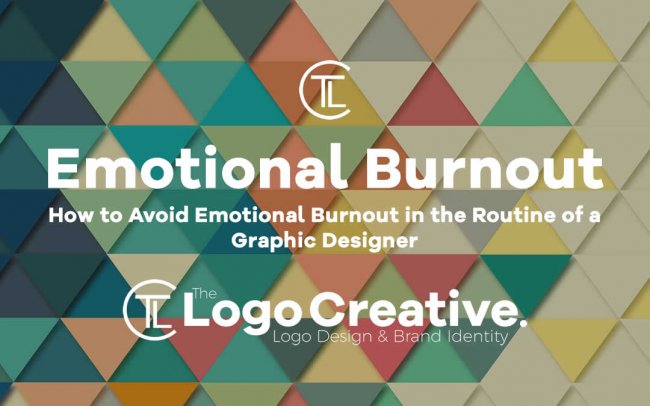Let’s face it straight away – every graphic designer experiences emotional burnout at some point in his/her career. As a matter of fact, it’s a widespread problem that affects professionals in all fields of work.
According to the study, 20% of employees report both high engagement and high burnout at the workplace. Another report shows that 23% of employees feel burned out at work very often or always, while an additional 44% feel this way occasionally.
This is obviously a huge problem for a number of different reasons, but how can a graphic designer deal with it? Is there a way to overcome the obstacle and avoid a creative drought in the long run? The short answer is: Yes, there is.
There are many ways to face this challenge, so we will show you here how to avoid emotional burnout in the routine of a graphic designer. Let’s take a look.
Table of Contents
Emotional Burnout: Definition and Consequences
Burnout represents exhaustion of physical and/or emotional strength or motivation usually as a result of prolonged stress or frustration. The definition itself is enough to figure out the cause of professional fatigue, but we will discuss it thoroughly in the next chapter.
At the moment, we want to explain what happens when graphic designers experience emotional burnout. Here is the list of the most common consequences:
- Apathy: Emotional burnout evokes the feeling of apathy, which is why graphic designers lose interest in work.
- Disengagement: This is the logical consequence of apathy since you gradually begin avoiding involvement in job-related activities.
- Hopelessness: At this stage of career, you are not willing to engage because you don’t see any real purpose in work.
- Detachment: It’s the inability to connect as you lack the desire to get the job done.
- Disorganization: With all the things we mentioned so far, it’s easy to guess that emotionally burned out graphic designers are disorganized. They don’t create a plan of work and don’t fulfill professional requirements.
- Procrastination: Disorganization usually leads to procrastination. You are constantly postponing activities and never get the job done 100%.
- Job loss: If your superiors notice the above-mentioned consequences of emotional burnout and realize that nothing is changing for a while already, you might as well lose your job.
- Physical health issues: Ryan Sims, a medical advisor at AssignmentGeek, says physical health issues often get neglected as one of the major consequences of emotional burnout: “Such a state of mind can cause physical disorders like insomnia, but it can even lead to the more serious problems such as diabetes or coronary diseases.”
9 Ways Graphic Designers Can Deal with Emotional Burnout
As you can see, emotional burnout can really hurt a graphic designer and have a long-lasting impact on his/her professional and personal well-being. In such circumstances, it is critical to face the problem and react quickly. We present you nine ways to do it:
Admit you have a problem
The first step in this process is very important because you have to cope with the challenge and admit you have a real problem. Take your time to think about what’s bothering you and what is it that you don’t like about your job.
As soon as you accept the truth that you are emotionally exhausted, you can start thinking about how to change the current situation and make the job interesting again. For instance, you can set a new career goal or simply change the usual daily routine – we will give you a few hints about that, too.
Take a break
A lot of graphic designers work at least 10 hours a day, which is the main reason why they end up being emotionally exhausted. The good thing about it is that you can react instantly.
First of all, you can choose to work less. As much as we all love being super-productive, it is not sustainable in the long-term perspective. Secondly, you should start taking more breaks throughout the day to freshen up and get your mind off work for a while.
But if small changes don’t make a big difference, we strongly recommend you unplug and take a vacation. Spend some time away from work and don’t answer calls, email, and messages. A week off is usually enough for most designers to recharge their batteries and eliminate emotional burnout.
Change the scenery
Another way to combat professional exhaustion is to change the scenery and work outside the familiar atmosphere. Avoid the office and colleagues you meet every day. Go to the local coffee shop or work from home from time to time. This trick doesn’t guarantee success, but it works for most graphic designers who don’t feel emotionally burned out so intensely.
Find a hobby
Finding a hobby seems like a childish thing to do for the vast majority of grown-ups, but this activity actually has a wide range of practical benefits. A hobby forces you to take a break and spend some time not thinking about graphic design.
Besides that, hobbies cause the so-called eustress, which is a positive form of stress that creates the feeling of thrill and excitement because you are about to engage in a joyful activity. At the same time, hobbies encourage you to learn new things and gain new skills.
It also gives you the opportunity to meet new people, join previously unknown communities, and find a fresh meaning in life. All this strongly impacts your emotional condition, so you can expect to overcome burnout soon.
Sleep more
We mentioned already that graphic designers who feel stressed out are likely to be overwhelmed with professional tasks and hence disorganized. It completely disturbs their usual behavioral patterns, while sleeping disorder represents only one of the major consequences.
What does it mean? It means you need to find a new rhythm that suits you the best and sleep more in order to get enough rest. It’s the only way to accumulate enough energy and make it through the day successfully. But if you get up feeling drained out, there’s no way to get rid of emotional burnout.
Embrace a healthy lifestyle
Sleeping habits are not the only thing that can reduce the feeling of emotional burnout. On the contrary, you should embrace a brand new lifestyle to feel fresh and energized every day. We recommend you begin exercising at least two or three times a week because it’s the most effective way to get rid of stress. Additionally, you can change your diet and eat healthier food. Concentrate on fruits and vegetables, avoiding strong food such as snacks, fries, red meat, and other groceries that can slow you down.
Professional diversity
If you feel stuck doing the same kind of job year after year, perhaps it’s time to change something and add some diversity to the professional life. One option is to switch to the new project or transfer to another department within the same company.
The second option is to come up with a new project on your own and propose it to the superiors, convincing them to give it a try. It should give you an entirely new wave of passion to work on something you really love. Both solutions are excellent ice-breakers that can change the status quo and help you move on to the next stage of your career.
Join a side project
Emotional burnout is often a consequence of professional overload, but sometimes the solution is not to work less. On the contrary, sometimes you just need a fresh source of motivation.
Side projects can be one of those sources of inspiration, giving you the opportunity to participate in new and exciting graphic design activities. You can apply as a freelancer, demonstrate professional skills, and who knows what happens next – it might even give you some unexpected career opportunities.
Attend industry events
The last tip on our list is to take part in industry-related events, meetings, and conferences. While it may not seem special at first, it is actually a great chance to meet graphic designers from all over the world, learn about the latest trends in your niche, and come back to work with a bag full of fresh ideas.
You should also consider it a work break because you don’t really have to do that much at conferences. Take your time to look around, attend some interesting lectures, and have a great time meeting your peers. We strongly believe this is one of the easiest but most productive ways to overcome emotional burnout.
Conclusion
Emotional burnout is a big problem that happens to almost every graphic designer sooner or later in their careers. If you don’t deal with this issue in a timely manner, it could have devastating long-term consequences both privately and professionally.
In this article, we explained the concept of emotional burnout and showed you nine ways graphic designers should deal with the problem. Emotional burnout is a challenging mental condition, so we really hope our post helped you spot the light at the end of the tunnel.
But if you need any additional explanations or advice on how to cope with this issue, leave us a comment and we will be there to answer you quickly!
 Author bio
Author bio
Alexandra Reay has been working as a journalist and editor in one of the finest Melbourne publishing agencies for 3 years. She is also a professional content writer who prefers to do research on the following topics – self-improvement, technology innovations, global education development ets. Feel free to contact her at Google+.

